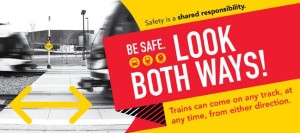Minnesota’s light rail system continues to make headlines for fatalities and accidents, and five years after a state audit found Twin Cities LRT ranked among the bottom half of its peers for safety measures, nothing has changed. Safety investigations immediately following light rail accidents and deaths are conducted by Metro Transit, which operates the lines. Metro Transit reports to the Metropolitan Council, a regional planning authority that advocates for new light rail lines.
Fatalities and accidents along Minnesota’s two existing light rail lines have been frequent news over the holiday season. The Star Tribune reports today that a wheelchair-bound man was struck and killed by 1 blue-line train last night near 32nd St. S. in Minneapolis. The accident is the 3rd metro light rail fatality in less than a month. Nurto Abdi Aden, 67,was killed by a green line train on December 10th, just after 11am, while walking in the designated crosswalk along University Avenue at Hamline Avenue in St. Paul. 29-year-old Jason McCormick, was on his bike near the intersection of 46th Street and Hiawatha Avenue in Minneapolis, when a blue-line train struck him around 6:30am on December 11th, he died the next day. Just days later, on December 14, two more pedestrians were struck by trains at the 46th Street and 50th Street blue line stations, although neither accident was fatal.
As of late December, there had been 107 accidents involving pedestrians, cyclists and vehicles on the blue-line, which runs along Hiawatha Avenue in Minneapolis, since the line opened in 2004. The green-line, which runs between downtown Minneapolis and St. Paul, through the University of Minnesota campus, has quadrupled that rate, with 60 accidents since service began in June 2014. Total fatalities caused by light rail in the Twin Cities stands at 16 people.
MPR reported that as of March of 2014, Metro Transit had determined that every single accident– up until that time– was the fault of the motorist, pedestrian, or cyclist involved. That spring, the agency announced: “Metro Transit has confirmed that a crash in downtown St. Paul earlier this year marked the first time in its 10 years of operation that a light rail train driver was at fault in an accident.” The 40-ton trains run up to 55 miles per hour, are very quiet, and run at street level throughout the Twin Cities.
In other cities where light rail operates, train drivers have been found to be driving too fast into stations and using cell phones while driving. After a Sacramento light rail train stuck and killed a homeless man in 2013, the California Public Utilities Commission (PUC) conducted a safety audit of its Regional Transit authority and found that light rail trains were entering stations at 35 miles per hour even though regulations dictated 20 miles per hour limits. Rather than comply, the RT stalled for two years, during which time another pedestrian was killed while crossing near a station, The Sacramento Bee reported. A new station on a California college campus will be placed at 8 inches below ground level to discourage people from crossing the line.
In Colorado, the state recently audited their Regional Transportation District which oversees buses and light rail trains according to the Denver Post. The six-month investigation reported to the state legislature that 19 bus and light rail operators had used cell phones to text and call while driving. The audit, conducted by a private firm, recommended cameras in the cabs of light rail trains, since there were none. While some Minnesota light rail trains are equipped with cameras to deter and investigate crime, a spokesperson for Metro Transit was unsure whether cameras were in the operator’s cab recording the driver, but promised to follow up on the question.
One potential conflict of interest is also how post-accident safety investigations are conducted. Metro Transit is responsible, but they report to the Metropolitan Council, which strongly advocates for new light rail lines and may not be the best watchdog since members are not publicly elected officials, but appointed by the Governor.
A January 2011 report from Minnesota’s Office of the Legislative Auditor on “Governance of Transit in the Twin Cities Region” tried to remedy this problem. The report found that “In 2009, the Twin Cities region’s bus system was among the safest of its peers; however, from 2005 to 2009, the light rail system ranked among the bottom half of its peers on safety measures.” The report recognized the lack of clear reporting authority stating that “the organization chart for transit in the Twin Cities is markedly complex” and concluded that “the governance structure for transit in the region is far from ideal” with 25 organizations involved with the planning, development, or operations for transit in the Twin Cities region. The report also found that the “Metropolitan Council’s lack of credibility among elected officials” produced the current situation and recommended reforming the Council to mix in government appointees and elected officials from the region.
Five years later, the advice to install a better reporting structure to handle critical tasks such as safety investigations hasn’t been heeded, and no elected officials serve on the Met Council. Instead, the current solution is for riders and pedestrians to pay better attention, as Metro Transit continues to review its safety procedures for the trains. The Star Tribune reports today,
Over the next month, the agency plans to post new warning signs and posters at platforms and inside rail cars emphasizing the proper way for motorists and pedestrians to interact with trains.
In the spring, it will continue work on a painting project started last year designed to steer pedestrians and bicyclists from areas deemed unsafe. It also plans to launch a pilot project that will make more lights on signs blink when trains pass by.
Met Council chair Adam Duininck issued a written statement after the two fatalities in December, “I have asked for, and Metro Transit has already begun, a comprehensive review of our safety procedures and equipment on our light-rail lines. I have also asked our staff to review any additional communications and outreach efforts we can undertake to amplify the message that safety is a shared responsibility.”
Meanwhile, the $1.8 billion Southwest Light Rail line blazes ahead, despite continual budget overruns, ground condition concerns at the line’s starting point in Eden Prairie, and citizen’s with The Lakes and Park Alliance of Minneapolis suing the Metropolitan Council for refusing to provide open access to public information about the planning of the line. Plans for the $1.5 billion Bottineau light rail line, which will run from Minneapolis to Brooklyn Park, also also moving forward.
A Metro Transit spokesman committed to follow up on our request for copies of past accident safety investigations as well as the current chain of command for reporting and acting on safety recommendations. Alpha News will continue to follow this story.












